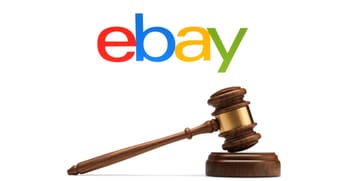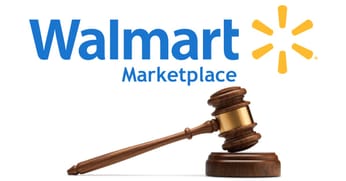Why Are eBay Managed Payments Fees So Complicated?
One of the most common questions I see come up again and again with Managed Payments is - how does eBay calculate the fees?
The eBay community is full of users struggling to make sense of exactly how the fees are being calculated. Even supposedly "payments trained" eBay reps seem baffled by the process - when eBay recently overcharged store sellers for final value fees I had 6 phone calls with 6 different eBay reps who came up with 6 different answers for how much the fees should have been - and they were all wrong.
There are several eBay fee calculators to be found online and some of them come very close, but still struggle because there are just so many factors to be considered, some of which can't possibly be known before the time of sale.
This fee calculator works well but is missing one key component - sales tax.
— Liz Morton ~ Value Added Resource (@ValueAddedRS) August 16, 2021
Unfortunately, #eBay's decision to include sales tax in fee calculation makes it impossible for an #ebayseller to know the exact fee upfront, since they can't predict the buyer's state. https://t.co/NK9g336t2t
To their credit, 3DSellers responded to let me know they will be adding sales tax to their eBay fee calculator soon.
The most accurate tool I've seen to date is this Fee Estimator from eBay Community volunteer ShipScript.
For clarity, all of the information provided below refers to US based eBay sellers in Managed Payments. I'm working on digging more into the fee structure for UK and other locations, but in the mean time, always refer to the appropriate eBay policy and help pages for your country.
Why Are eBay Managed Payments Fees So Difficult To Calculate?
The short answer is - it's complicated.
The first hurdle is to determine the "Simplified Fee" percentage applicable for your category and store subscription level.
Back in the Spring 2021 Seller Update, eBay announced there would be fee increases in some categories. Many sellers asked for a side by side comparison chart to see which categories would be increasing. eBay did not provide such a chart, stating they believed it was "extremely complex and not something that was probably going to be understood by even us internally, much less those externally that we were trying to help understand."
I help them out by creating a side by side comparison chart at the time:
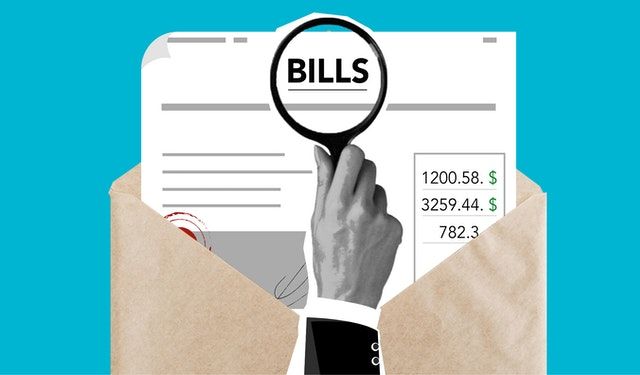
For the most current and up to date Managed Payments fee information from eBay directly, sellers should look here if they are not an eBay store subscriber and here for starter to enterprise store subscriptions.
Once you've determined what percentage is applicable for your particular category and store subscription status, it's important to understand the fee is calculated on the total sale amount: item price + shipping charged to buyer + sales tax plus a $0.30 per transaction fee.
The inclusion of sales tax in the calculation has been a particular sore spot for many sellers, especially now that they are eBay's legal obligation to collect and remit under Marketplace Facilitator Remote Tax laws.
The sales tax money is not paid to the seller and never touches their account in any way, but is still included for purposes of calculating the fees.

Since the seller has no way to know which state their eventual buyer will be in, it's impossible to accurately calculate ahead of time what the exact fees will be.
The fee estimator from ShipScript linked above does allow you to manually enter a tax rate so you can test to see what the effect will be on fees if your item sells to a state with a 5% sales tax rate vs 9%, for example.
Unfortunately, an estimate is the best you can do - most sellers will likely err on the side of caution and price their items with their target profit margin in mind accounting for the highest possible tax rate.
The flip side of having the total with tax included used to calculate fees is it's also used to calculate the the 10% Top Rated Seller+ discount. For Top Rated Sellers whose listings meet the criteria, eBay gives a 10% credit on the Simplified Fees.
I've seen a lot of confusion about this one as well, mostly because eBay does not label the credit specifically as "Top Rated Seller Discount", instead giving it a generic label of "special promotion".
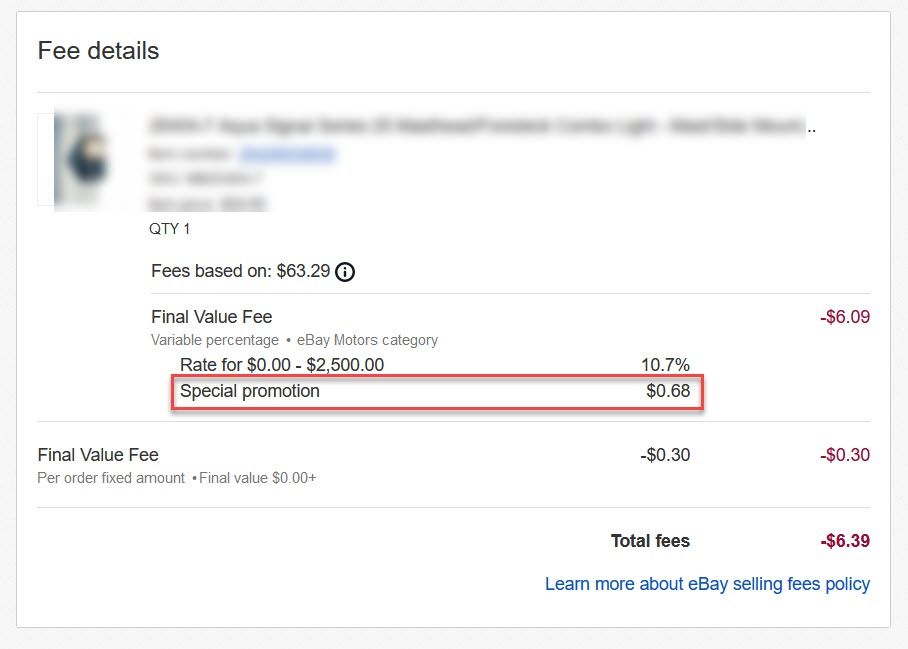

So in this example the total including any shipping or sales tax was $63.29. The fee calculation goes like this:
$63.29 x 10.7% = $6.77
TRS+ "special promo" is $6.77 x 10% = $0.68 (rounded)
$6.77 - $0.68 = $6.09
$6.09 + $0.30 per transaction fee = $6.39
But Wait.....There's More!
That example transaction is relatively straightforward by Managed Payments standards, but there are several scenarios that could add even more complexity to the calculations.
Don't ship internationally? It doesn't matter - if your buyer is registered outside the US, but is using a US based shipping address/freight forwarder, you'll be charged an additional 1.6% international fee.

If you do sell internationally, there will be currency conversion fees.
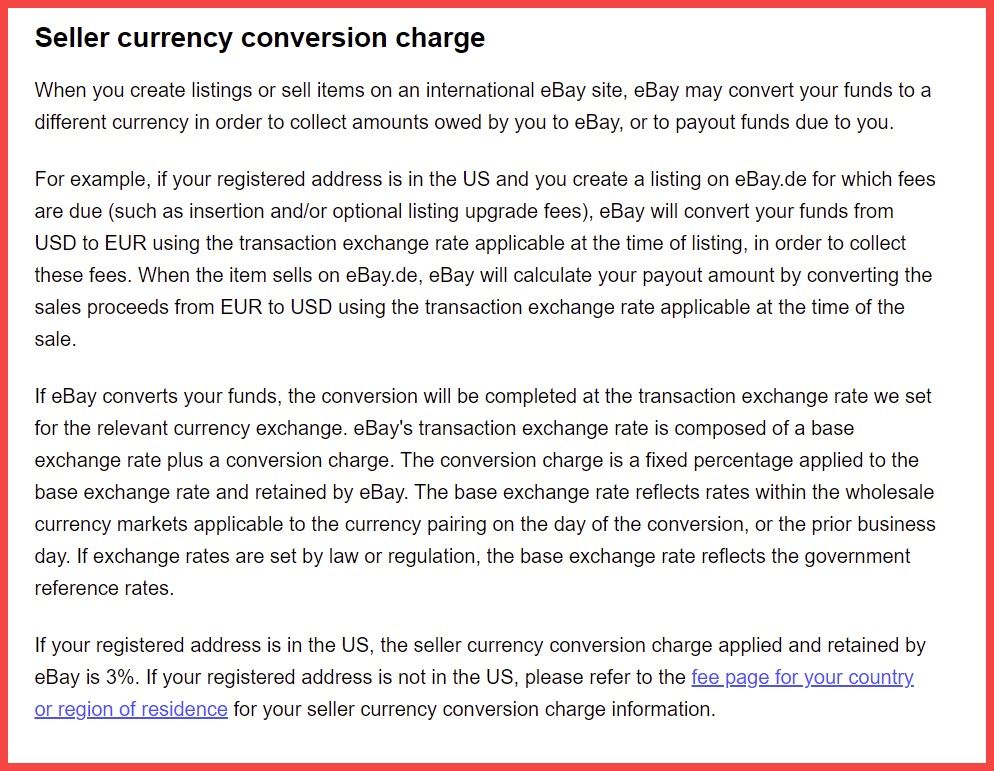
Also, if your Seller Status falls Below Standard or your Service Metrics are evaluated as "Very High" - you'll be charged an additional 5% in fees.
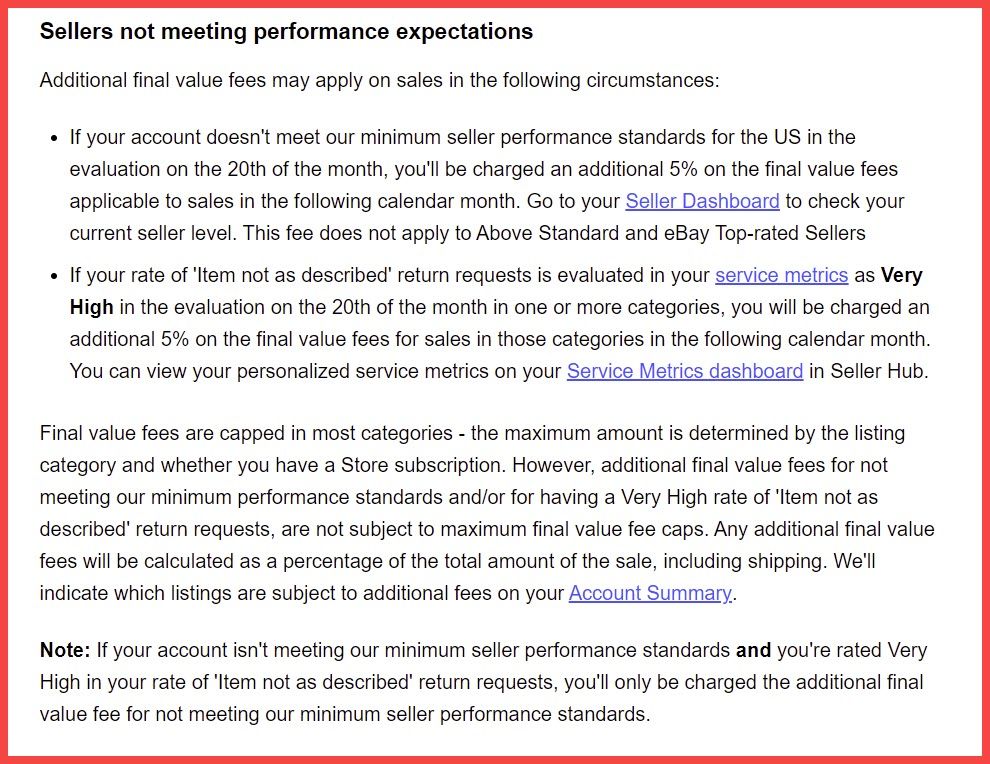
What About Advertising?
eBay VP of Global Advertising Alex Kazim has often said that eBay's Promoted Listings Standard advertising option is unique to the industry because it is based on a cost per action/cost per sale model rather than cost per click.
For Promoted Listings Standard, the seller elects an ad rate that is a percentage of the total sale to promote the listing. Because sellers only pay the Promoted Listings fee when and if a sale occurs within 30 days of the buyer clicking on the ad, most sellers consider these ad fees to be part of the total fees for the sale.
eBay doesn't agree with sellers on this point and considers these ad fees as "listing based" fees not "transaction based" fees. They are listed as separate line items in Managed Payments reporting and have a memo referring back to the item number of the specific listing, but they do not tie the fee to a specific sale/transaction.
I've suggested to eBay before that bringing their reporting more in line with the seller viewpoint on this by showing the ad fees at the transaction level would be very helpful, but I suspect it's not likely to happen any time soon - most likely due to the same attribution challenges eBay faces with showing whether or not Best Offers will incur Promoted Listings fees.
Until eBay is able to solve whatever issue causes some ad attribution not to show in real time, sellers will either have to dig through Managed Payments reports to match up ad fees to transactions after the fact or use either one of the fee calculators mentioned above to see how various ad rates may affect the overall profit margin on their sales.
So, What's The Long Answer?
I said above the short answer is, it's complicated. The longer answer requires asking the question - why is it so complicated?
When eBay initially introduced Managed Payments in 2018, the pitch was all about the savings - claiming most sellers would see an average of 25% savings vs. PayPal.
eBay’s 2.7% processing fee and no per transaction fee at the time easily beat PayPal’s 2.9% + $0.30.
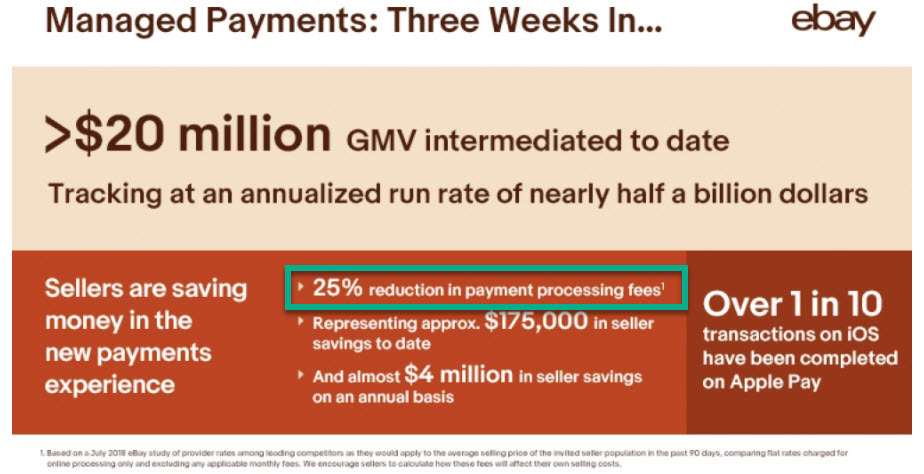
The $0.30 per transaction savings was specifically highlighted in this article by Alyssa Cutright, VP Payments.
Most exciting to Danny, and to many of our other sellers, is their lowered costs. “When I decided to sign up for managed payments, it was really about the 30 cents savings. I do more than 5,000 sales in a year, so that savings adds up to over $1,500 back in my pocket. If you’re a higher volume seller, that 30 cents adds up fast. It’s a huge advantage for me.” Danny told us.
Overall, sellers in managed payments are benefitting from reduced costs:
- A 25% reduction in their payment processing fees1;
- This reduction represents approximately $175,000 in seller savings to date;
- This translates to almost $4 million in seller savings on an annual basis.
Fast forward to May 2020 when eBay introduced the Simplified Fee Structure which created a single fee to cover both the Final Value Fee and Payment Processing Fee together, plus a $0.30 per transaction fee.
Originally the Simplified Fee was applied only to item price + shipping and was still fairly straightforward with the possible savings to sellers easy to see.
This example was provided by eBay in the announcement for the new fee structure.

However, on September 1st, 2020 eBay began applying the full Simplified fee on the total sale amount of sale including tax.
This change made it much harder to calculate if there would be savings in Managed Payments vs. PayPal. Generally speaking, sales to no tax states would see the most savings, lower tax rate states would see small savings or would be neutral, and higher tax rate states would likely see an increase in fees.
eBay has made no secret of the fact that payments and advertising are their main focus for revenue growth - just read the transcripts from any quarterly earnings call in the last few years. The biggest headwind eBay faces on those fronts is seller sentiment.
eBay could have chosen to go for a more upfront and straightforward fee structure and in fact in the early stages of Managed Payments did just that. So why the sudden change of course just before the big push to onboard the majority of sellers into the program?
I can't speak for eBay of course, but my take is the "Simplified" fee is not simpler for sellers - it is simpler for eBay to employ the "ratchet effect" to increase take rate over time without drawing too much attention to the true overall cost of doing business on the platform.
Unfortunately, if that is the case, I don't think eBay is going to have much incentive to make Managed Payments either truly simpler or more transparent any time soon.
Follow Value Added Resource on Twitter & Facebook ✔
Subscribe to receive eBay seller news, tips, and insights in your inbox 📧
Interested in being featured in the Seller Spotlight? Tips, story ideas or guest post recommendations? Contact me here!
Share with friends and leave a comment 👇









